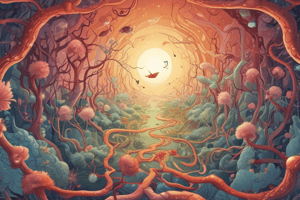Podcast
Questions and Answers
Which branch of biology focuses on the study of microorganisms like bacteria and viruses?
Which branch of biology focuses on the study of microorganisms like bacteria and viruses?
- Zoology
- Ecology
- Microbiology (correct)
- Botany
What type of biological molecule provides energy and structure for living organisms?
What type of biological molecule provides energy and structure for living organisms?
- Lipids
- Proteins
- Nucleic Acids
- Carbohydrates (correct)
Which of the following is NOT a function of proteins?
Which of the following is NOT a function of proteins?
- Regulation
- Catalysis
- Photosynthesis (correct)
- Transport
What is the basic unit of life?
What is the basic unit of life?
Which of these processes is NOT a function of cells?
Which of these processes is NOT a function of cells?
What is the study of heredity, genes, and genetic variation called?
What is the study of heredity, genes, and genetic variation called?
What type of biological molecule stores and transmits genetic information?
What type of biological molecule stores and transmits genetic information?
Which branch of biology studies the interactions between organisms and their environment?
Which branch of biology studies the interactions between organisms and their environment?
Flashcards are hidden until you start studying
Study Notes
Definition and Scope
- Biology is the scientific study of life and living organisms, including their structure, function, growth, evolution, distribution, and taxonomy.
- It explores the diversity of life on Earth, from the simplest bacteria to complex ecosystems.
Branches of Biology
- Botany: study of plants, including their structure, growth, evolution, classification, and distribution.
- Zoology: study of animals, including their structure, behavior, evolution, classification, and distribution.
- Microbiology: study of microorganisms, such as bacteria, viruses, and other microorganisms.
- Ecology: study of the interactions between organisms and their environment.
- Biochemistry: study of the chemical processes that occur within living organisms.
- Molecular Biology: study of the structure, function, and interactions of biological molecules, such as DNA, proteins, and cells.
- Genetics: study of heredity, genes, and genetic variation.
- Evolutionary Biology: study of the processes that have shaped the diversity of life on Earth.
Biological Molecules
- Carbohydrates: provide energy and structure for living organisms.
- Proteins: perform a wide range of functions, including catalysis, transport, and regulation.
- Lipids: provide energy and structure, and are a major component of cell membranes.
- Nucleic Acids: DNA and RNA, which store and transmit genetic information.
Cell Biology
- Cell Structure: cells are the basic units of life, consisting of a cell membrane, cytoplasm, and genetic material.
- Cellular Processes: cells undergo various processes, including metabolism, photosynthesis, and cell division.
- Cellular Organization: cells are organized into tissues, organs, and systems that work together to maintain homeostasis.
Genetics and Evolution
- Mendelian Genetics: the study of how traits are inherited, based on the laws of Mendelian inheritance.
- Molecular Genetics: the study of the structure and function of genes at the molecular level.
- Evolution: the process of change in the genetic makeup of a population over time, driven by natural selection, genetic drift, and other mechanisms.
Ecosystems and Ecology
- Ecosystems: communities of living and non-living components that interact with each other.
- Ecological Relationships: organisms interact with each other and their environment through predation, competition, symbiosis, and other mechanisms.
- Ecosystem Services: ecosystems provide essential services, including air and water purification, climate regulation, and nutrient cycling.
Definition and Scope
- Biology examines life and its organisms, emphasizing structure, function, growth, evolution, distribution, and taxonomy.
- Investigates the vast diversity of life, ranging from simple bacteria to intricate ecosystems.
Branches of Biology
- Botany: Focuses on plants, covering aspects like structure, growth, evolution, classification, and distribution.
- Zoology: Explores animal life, including structure, behavior, evolution, classification, and distribution.
- Microbiology: Studies microscopic organisms, such as bacteria and viruses.
- Ecology: Analyzes relationships between organisms and their environments.
- Biochemistry: Investigates the chemical processes that underlie biological functions.
- Molecular Biology: Examines the structure and interactions of biological molecules, including DNA and proteins.
- Genetics: Concerned with heredity, genes, and variations in genetic traits.
- Evolutionary Biology: Studies the processes that have influenced the diversity of life forms over time.
Biological Molecules
- Carbohydrates: Serve as energy sources and structural components in living organisms.
- Proteins: Participate in various biological functions such as catalysis, transport, and regulation.
- Lipids: Act as energy reserves, structural components, and important elements of cell membranes.
- Nucleic Acids: Comprise DNA and RNA, responsible for genetic information storage and transmission.
Cell Biology
- Cell Structure: Cells are the fundamental units of life, made up of a membrane, cytoplasm, and genetic material.
- Cellular Processes: Engage in essential processes like metabolism, photosynthesis, and division.
- Cellular Organization: Cells form tissues, organs, and systems, working in harmony to achieve homeostasis.
Genetics and Evolution
- Mendelian Genetics: Explores inheritance patterns of traits based on Mendel's laws.
- Molecular Genetics: Investigates gene structure and functions at a molecular dimension.
- Evolution: Refers to changes in population genetics over time, influenced by factors such as natural selection and genetic drift.
Ecosystems and Ecology
- Ecosystems: Comprise communities of living organisms and their physical environments, emphasizing interactions.
- Ecological Relationships: Analyze interactions like predation, competition, and symbiosis that occur among organisms.
- Ecosystem Services: Highlight the critical benefits provided by ecosystems, including air and water purification, climate control, and nutrient recycling.
Studying That Suits You
Use AI to generate personalized quizzes and flashcards to suit your learning preferences.




